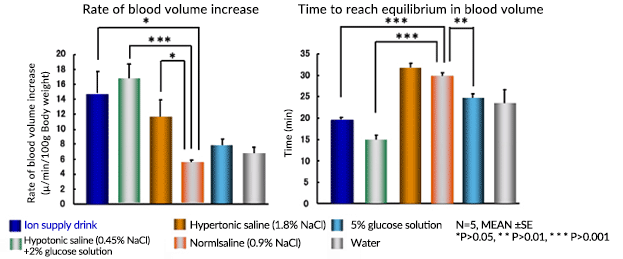Changes in blood volume following administration of oral rehydration solutions
Morita M, Nose H, Morimoto T
Journal of Clinical and Experimental Medicine 1988; 145: 773-774
Purpose
During dehydration, it is essential to compensate for the decreased blood volume through adequate water replenishment. Few studies have been conducted on the changes in blood volume after fluid intake. The purpose of this study was to determine what changes occur in blood volume after the administration of solutions with different compositions of sodium and glucose by continuously measuring the blood volume in rats.
Methods
An experiment was performed using five male Wistar strain rats, in which the body temperature was maintained at 37℃ under anesthesia. Each rat received one of the test solutions of normal saline (0.9% NaCl), hypertonic saline (1.8% NaCl), a mixture of hypotonic saline (0.45% NaCl) and 2% glucose solution, 5% glucose solution, water or an ion supply drink through a gastrostomy* at a rate of 1 mL per 100g of body weight in 10 minutes. The circulating blood volume was continuously measured by the dilution method using 51Cr-labeled red blood cells.
- *Gastrostomy is a surgical procedure wherein a tube is inserted through the abdominal wall and into the stomach to provide a means of feeding or hydration.
Results
The rate of blood volume increase was significantly higher in the hypotonic saline + 2% glucose solution, hypertonic saline and ion supply drink groups than in the normal saline group, with the highest rate in the hypotonic saline + 2% glucose solution group. The time at which the blood volume reached equilibrium was longer in the hypertonic saline and normal saline groups. The time to equilibrium was shorter in the hypotonic saline + 2% glucose solution group, followed by the ion supply drink group, with a significant difference between these groups and the normal saline group.
Conclusion
The rate of blood volume increase was higher for the hypotonic saline + 2% glucose solution and ion supply drink compared to normal saline, suggesting the potential influence of glucose on the increase in blood volume.









